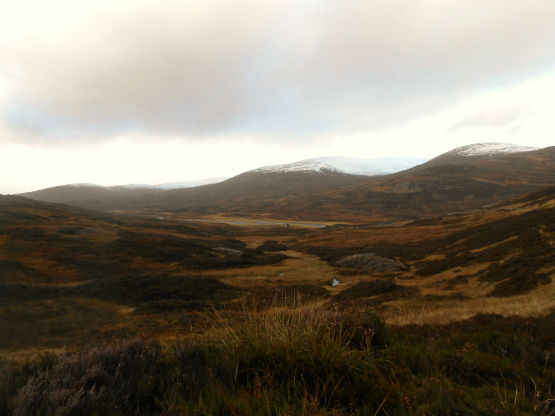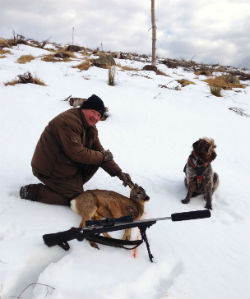Chris Dalton offers some pointers on developing a deer management plan for Doe and Hind culling during the winter months.

This is the time of year when most of us are turning our attentions to the Doe and Hind Cull and I am frequently asked how we tackle that in South Ayrshire. It’s also a time I particularly enjoy, the dreaded midge has gone, the cover is down and we get those lovely frosty mornings with clear blue skies and you can sit and relax over a meal and a dram or two in the evening and still have a good night sleep and lie in to around 6 am, bliss! Which is not to say that I do not enjoy the magic of 3 am on a summer morning, trying to find that elusive roe buck, because I do, but the longer, darker nights also have a charm of their own, and certainly far more civilised hours.
But it’s those long summer days when you should start to formulate your doe cull. I am constantly watching where the does are and what they are doing. I monitor them. This is particular important during the rut, noting the locations of the young and the more mature does.
 We spend a lot of time on the ground at that time and by the end of August I have a very clear picture of my does and also how good the retention rates are. I am particularly noting the does with single kid and those with twins: we also have a smattering of triplets. If you are seeing a high number of twins or more, then your current management plans, certainly in terms of deer welfare are right.
We spend a lot of time on the ground at that time and by the end of August I have a very clear picture of my does and also how good the retention rates are. I am particularly noting the does with single kid and those with twins: we also have a smattering of triplets. If you are seeing a high number of twins or more, then your current management plans, certainly in terms of deer welfare are right.
("Get on with the Doe Cull straight away, you may think you have lots of time but you don't" Left: client with a Roe Doe)
If you have too many deer on the ground you will start to note the key indicators, not least of which will be a less than pleased landowner complaining about crop damage! A reduction in birth and retention rates and an increase in infant mortality will rapidly become evident. I also try to have an idea which does have lost kids; admittedly, this can be accidental, modern farming with quick machines at the silage cut for example, or road deaths, which undoubtedly account for a lot of kids, but a doe without kids moves up the cull list.
So by the time November comes round, Tony and I will compare notes and will have a good idea of where our doe cull needs to be. That is not to say that this is an exact science, as it most certainly is not. A lot of factors can change things quite rapidly and you can all of a sudden have an ingress of deer or in fact the opposite, you may suddenly face a serious poaching situation and some land can be very vulnerable to this, particularly remote areas with quiet county roads passing through where shooting from vehicle at night with the lamp can rapidly reduce your deer and be difficult to catch the culprit. But you should be aware of these external factors, which is where being able to put time in on the ground is never time wasted.
So you now have a good idea of where your deer are and in what ratio, male to female etc, so where do you start? Well you have to start somewhere! And you will not go far wrong working on the ratio of 60% young to 20% old and 20% mature. In subsequent years it becomes slightly easier for 2 main reasons;
Firstly, that you know the ground and your deer’s behaviour patterns better and, secondly, you can monitor next year’s deer sightings and numbers against this year’s cull, allowing you to adjust up or down accordingly.
Perhaps one of the key bits of advice I would give is to get on with it straight away. You may think you have plenty of time but you don’t! It’s a short season and all manner of things can come along and get in the way: the weather can turn, game shooting interests may prevent access to woods and crop/tree planting to name but a few.
The policy that has always stood me in good stead is to take the followers, concentrating where you can on the does with twins and to take any does without kids; a high percentage of these will be old or yearling does. I often hear, ‘’ shoot the doe and the kid will stay and you can then shoot that as well ‘’, it may do, but it may also run off and then you have to spend a lot of time going back to find it, as it probably won’t survive the winter without the guidance of the parent. Shooting the mother is a policy I don’t like and to be honest I don’t think it should form part of responsible deer management, we should be all about humane killing with the minimum chance of suffering to any animal.
Even if you are under pressure to reduce deer numbers rapidly then surely it’s better to account for the kids first and take the doe immediately after if the opportunity allows; and if not then take her at a later date. You must accept that the key to controlling deer and deer populations, rests crucially in the control of the females, a lot of women will not necessarily produce a lot more deer or a lot more bucks; the opposite is in fact the case. So the doe season is the most important time for the deer manager and it is crucial that the right amount of effort, time and importance is attached to the task.
Some years ago I looked after, still do for that matter; a fairly large block of conifers in a felling rotation, so is was very vulnerable in terms of deer control, with blocks of new conifers being planted along with hardwoods on a regular basis. I had done the ground work and established where a lot of the does were and also retention rates all in line with my advice above. This was great until the doe season opened and all of a sudden I couldn’t find them, apart from a few sightings I just was not seeing the deer. A bit like cocks only in January where every bird over the line is a hen! So after a few trips I left the ground pretty much alone and concentrated on other plots. That was until I got a call from the awfully nice forest manager in early December who, shall we say, was less then pleased! After a routine inspection and driving past a newly planted block in the lovely winter sunshine he had seen 9 does with attendant followers enjoying the tips of his expensive trees. I was over that afternoon and quite shocked at the extent of the damage caused, suffice to say i spent a lot of time in that forest over the next month doing the job I should have done from day one !
So unless there is a specific and tangible reason to adjust you planned doe cull then stick to it or face an onslaught from and angry landowner or forest manager, or worse, he might get someone else to do the job!!
Chris Dalton is a highly respected Deer Manager in Scotland and runs Ayrshire Stalking, to contact Chris Tel: 07710 871190



















